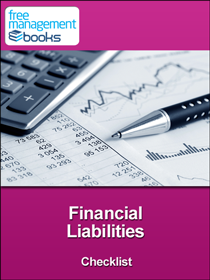Financial Liabilities Checklist
 |
||
 |
||
This Financial Liabilities checklist enables you to quickly identify whether you are dealing with a liability or not when handling management finances. It also aids your ability to understand this aspect of an organization's balance sheet.
This checklist enables you to quickly identify whether you are dealing with a liability or not when handling management finances. It also aids your ability to understand this aspect of an organization's balance sheet.
An organization's liabilities are its legal obligations or debts that occur as a result of operating the business or service organization. It includes the following items:
Loans
Mortgages
Accounts Payable
Deferred revenues
Accrued expenses
The balance sheet lists liabilities of an organization under two headings:
Current Liabilities
Long-term Liabilities
These two forms of liabilities plus the equity within the organization will balance with its assets; the credit side of this financial statement.
Current Liabilities
These are items that are due or must be paid within a year.
This includes payable items such as employees' wages, accounts, accounts payable, taxes, and unearned revenue when adjusting entries. It also includes the portion of any long-term bonds that need to be paid in the current year, as well as short-term obligations such as the purchase of equipment.
The typical headings used for current liabilities are:
Accounts Payable - details unpaid suppliers & service providers listed in accordance to trade terms e.g. 30-days.
Accrued Payroll - employees are usually paid in arrears so this section includes what is owed, but not yet paid to employees. Any taxes to be paid that relate to this sum will be listed separately.
Other Accrued Liabilities - as the balance sheet is a snapshot of an organization's finances on a particular date there will be expenses that have been incurred but an invoice has not yet been received. This section is where the liability of these types of expenses is estimated.
Notes Payable and Other Bank Debt - loans and monies borrowed will have their own specific repayment terms and they will be recognized under this heading. (it does NOT include trade account terms.)
Current Portion of Long-term Debt - For example, an organization has taken out a 10-year loan this heading would only include the loan and interest payments for the current 12-months.
Long-term Liabilities
These are items that are due or expect to be paid after 12-months of the date of the balance sheet.
This section includes any debts or non-debt financial obligations that are due for payment after at least 12-months of the balance sheet date.
The typical items you will find listed under this heading are:
Notes payable
Pension obligations
Long-term leases
Long-term bonds
Long-term product warranties
Long-term debt
Shareholder loans
In certain circumstances the value or the timing of the liability will be uncertain and these will be referred to as 'provisions' in the balance sheet.
The long-term liabilities section of the balance sheet will also detail any long-term loans or loans from shareholders that the organization has received. It will subtract the figure of the current portion of the long-term debt that has been included under current liabilities.

